

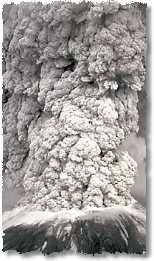 Volcano Facts
Volcano Facts
Alaska and Hawaii have a lot of volcanic activity, but the entire western coast of North America has dozens of active volcanoes, all capable of erupting in the near future. A volcano eruption is not much of a danger for the vast majority of the population, but its good to know the facts and have useful information before you visit a risk area.
A few bits of volcano info to ponder:
- In the past 300 years, over 40 volcanoes have erupted in Alaska, some of them over 20 times each.
- In the Cascade range along the west coast of the U.S., there are 68 active volcanoes and 7 have erupted in the past 200 years.
- A volcano eruption can trigger earthquakes, tsunamis, flash floods, and landslides.
- The high risk area around a volcano is about 40 miles across, but problems from ash can extend hundreds of miles.
- Over 80% of the earth's surface was created by volcanic activity.
- More than 500 active volcanoes exist. The highest concentration is an area encircling the Pacific Ocean called the Ring of Fire - it contains over half of them.
-
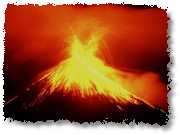 Recent Events:
Recent Events:
- Mount St. Helens was dormant for over 100 years before erupting in 1980, killing 58 people and doing over $1 billion in damage.
- The rock exploding from Mount St. Helens traveled at 250mph and was still going 60mph when it was 15 miles away.
- Oregon's Crater Lake is a volcano that blew its top off about 6500 years ago.
- Mt. Pinatubo in the Phillipines killed 342 people and caused the evacuation of 250,000 in 1992.
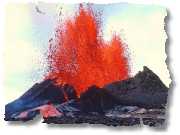 Volcano Danger
Volcano Danger
The further from the volcano you are, the more time you have to respond and the fewer dangers exist. Immediately around the volcano, dangers include earthquake damage, flying rocks, heat blast, lava, floods, and mudslides. Rocks can be thrown 20 miles from a volcanic eruption but the ash can travel hundreds of miles.
Ash facts include:
- can dissipate into the high altitude windstream and travel around the globe, possibly causing world-wide temperature changes.
- can clog water systems, damage vehicle engines, make walking slippery, and effect vegetation.
- can damage lungs and cause respiratory problems because it is extremely abrasive. It can also scratch eye tissue.
- can accumulate and collapse buildings. 1 inch of ash weighs up to 10 pounds dry and up to 15 pounds when wet.
- can short circuit electrical items such as computers.
- can cause power outages which often happen after an eruption.
- can corrode metal with long-term exposure.
- can linger and cause problems for months and months after an eruption.
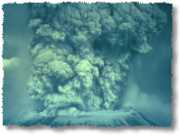 Before a Volcano
Before a Volcano
There is usually plenty of warning that a volcano is preparing to erupt. Scientists monitor the Cascade range volcanoes as well as those in Hawaii and Alaska for information to help predict volcanic events. Many communities close to volcanoes now have volcano warning systems to alert citizens. But, if you live anywhere in Washington, Oregon, California, Idaho, Utah, and possibly Wyoming and Nevada you may be affected by an eruption in the Cascade range. Taking a few precautions now won't cost much and are a good idea to do anyway:
- Keep 3 extra air filters and oil filters on hand for your vehicle.
- Keep 3 extra filters for your home heating/cooling system.
- Keep a roll of plastic wrap and packing tape so you can wrap and protect computers, electronics, and appliances from ash.
- Store emergency food and water in your home.
- Find out if your community has a warning system and know the warning signs.
- Create an evacuation plan. It is best to head for high ground away from the eruption to protect against flood danger.
- Define an out-of-town contact for all family members to reach to check in.
- Besides your family emergency kit, have disposable breathing masks and goggles for each family member.
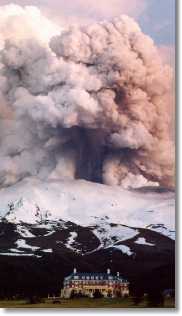 During an Eruption
During an Eruption
Much like a tsunami, a volcano is usually a sudden, explosive disaster requiring immediate evacuation to a safer location. The rock debris, pyroclastic flows, and floods will make the area around the volcano dangerous to anyone that stays. The lower valleys will be most dangerous.
- Follow the directions of authorities.
- Take your family emergency kit and evacuate.
- Evacuate to an area upwind rather than downwind if possible.
- When evacuating, if you are in a valley, or close to a stream, or crossing a bridge, check upstream for mudflows. A mud flow is extremely heavy and can destroy a bridge quickly. Take a different route or get to high ground quickly - mudflows can be extremely fast too.
- Seek shelter indoors if possible.
- Close all windows and doors to keep ash out. Seal up drafts. Do what you can to keep ash out.
- Seek higher ground - flash floods, mud, and poisonous gasses will accumulate in low-lying areas.
- Put on long pants, long-sleeved shirt, and hat.
- Wear a dust mask or wetted handkerchief to help filter ash.
- Leave your vehicles turned off until the eruption has ended and the dust can settle. Ash destroyed many vehicle engines during the Mount St. Helens eruption.
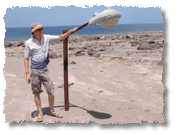 After an Eruption
After an Eruption
There is still danger after an eruption even if there is no flowing lava. The fact is, it may take years for the environment to recover from the changes caused by the volcano. And, ongoing tremors and further eruptions may make the area uninhabitable for a long time. In the short-term, recovery and clean-up includes:
- Stay inside and listen for volcano information on your radio or tv.
- Minimize your movements and keep all windows and doors closed.
- Keep your skin covered with long pants, long-sleeved shirt and hat to avoid irritation from ash.
- If you have to go outside, where a dust mask and eye goggles.
- Drive slowly and carefully with your lights on - the ash is slippery and stirring it up will clog your enginge. If you do any driving in the ash, there is a good chance you will destroy your engine. Change your oil and air filters after 100 miles at the most when driving through heavy dust.
- Remove ash from your roof if you are concerned about its weight. More than 3 or 4 inches may be too much.
- Spray your yard with your water hose to dampen the ash. This helps keep it from blowing around more. Use as little water as possible.
- Check with your neighbors to see what help they need.
- Shake off and remove your outdoor clothes in your garage before going inside.
- Use your vacuum to dust - dustrags will act like sandpaper rubbing the ash around.
- Check in with your emergency contact to let them know your status and plan.
- Check with authorities on guidelines for ash removal and disposal.

Find Emergency and Disaster Info at www.EmergencyDude.com

